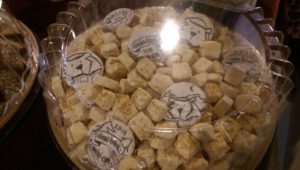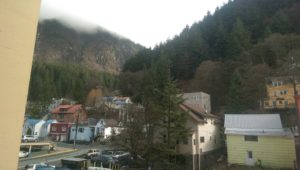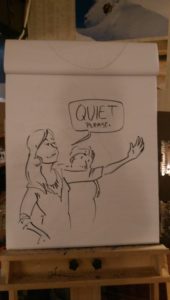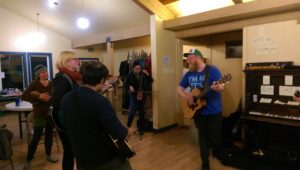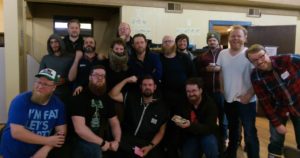Camp 2018, Part Five
The Egg Situation at Breakfast on Monday is off the hook; it’s a scramble/caprese deal, more delicate and loved that even Ray Smuckles would manage.
The structure of the programming has loosened; yesterday, a considerable number of games were conducted, role-playing and otherwise, and space in the schedule is being made so that people can improvise. Scott C talks about how to find inspiration while Sophie Lager (a local artist and musician, and all-around awesome lady) shows me how to cast yarn onto needles. I spend the rest of Camp adding knit stitches into something that nothing in particular, letting the physical work allow my mind to drift¹. I suspect Scott C’s journey through art and artists that inspire him will always come to mind when I have needles in my hands.
When I first mentioned to Dylan Meconis at last year’s Camp that I wanted to learn to knit, she immediately declared that I’d be great at it. It’s all just math, Gary she told me. Now I can see the geometry of the yarn hangs together, and I’m reminded of ropework that I’ve practiced in my habit of rock climbing. I’ll eventually abandon the mutant first project (Meconis told me to pick a skein of wool in a color I didn’t care about, so I wouldn’t be precious about unraveling as needed) and start a second practice work: 20 stitches wide, careful counting, uniform slack. It’s got about 1000 stitches in and I haven’t picked it up for nearly two weeks, but I’ve got flights for work next week and I suspect it’ll be in my carry-on. Eventually, I may even learn a second stitch.
I learn a bit later that as long as I keep my hands within my peripheral vision, I can knit and use language; brains are funny things — I learned from a decade of work commuting that I can’t listen to podcasts or music and talk or read or fill in a crossword, but I can do sudoku. Likewise, knitting and conversation flow together when Lucy Bellwood hosts a conversation on how to sustain a [creative] career. Bellwood’s rightly known for her large personality and adventurous nature, but she’s also the perfect moderator of a discussion that deals with smaller, quieter issues — emotional stability, worries about money, confidence in your work and place. The leap she took in sharing her little jerk and speaking about him honestly has made her a center in this quirky culture.
The sense of community is more powerful than I recall from last year, maybe because this year I’m a little more in control of my impostor syndrome. It’s revivifying to be around people who are insanely creative, innately good-hearted, willing to let down their hard-earned defenses (remember, most of them make their living in large part on the friggin’ internet, and a majority of this year’s attendees are women), to talk honestly about their ambitions and their own little jerks.
I’ll tell you that this discussion took place, for this block of time on Monday afternoon and throughout the rest of the weekend. That’s all I’ll tell you. But I will urge you — if you haven’t already — to find a similar intentional community within your own geographic/professional/whatever circles and to allow yourselves the same sort of discussions. I said it more than once to friends since I first attended, but I’ll say it now for public consumption: for me, attending Comics Camp is better than a year’s therapy.
Part of that is because Pat Race (and he’s far from the only person that makes Comics Camp run, but he’s the heart and soul of it) is very, very aggressive about soliciting and acting on feedback. He wants to know about how we’ve experienced the logistics and arrangements, the activities and scheduling, both before and during Camp. He talked about how school the visits worked, about how after three years the students finding continuity; he asks our opinions on the Library show and the involvement of the community at all stages. It’s universally agreed that everybody loved what Lily and Ishmael Hope shared with us, and would like to see more exposure to local culture in future.
Maybe it’s because it’s the last day, but the main lodge seems to hold more people than any time since arrival; our banner is hoisted, POoOP Number Two voting continues, people circulate in ever-changing swirls. After dinner, there’s a rundown of how Tuesday morning will go — breakfast, followed by cleanup, and a bus departure for those on the cartoonist-heavy flight to Seattle at lunchtime. And there’s a special presentation to Jeste. You may recall that when introduced to us, Jeste announced she had a requirement. You’re all cartoonists, she declared, and nobody’s drawn me yet.
Well. Let it not be said that cartoonists are not up to a challenge.
Over the weekend the Jeste Shrine takes form; from the high altarpiece — it reads Our Lady Of Dank Snax — which lights up to the many, many portraits, it continuously grows and changes. Each time I take a picture, it has a new representation of Jeste that needs to find room for inclusion. I think my favorite is by Vera Brosgol, who’s drawn Jeste like one of the summer camp kitchen ladies in Be Prepared. She’s a bomb-ass chef, she fed us better than anybody would expect from a summer camp kitchen, and she is beloved.
Tuesday morning passes quickly, but not before a drizzly group photo; my flight isn’t until stupid early on Wednesday; others will be around until late afternoon or evening. Those of us not on the early bus spend a little extra time cleaning the lodge and kitchen, before making our way back to town. Shing Yin Khor and I have Mexican, then are called over to the local distillery for delicious gin drinks by Marian Call.
That night, I end up going to see The Avengers: Infinity War with Call, Race, and some of the other local Juneau folks, a reintroduction to the machinery of mass culture after days of being away. I’d started tapering off my email checking and Twitter habit before heading into the woods, and the lack of cell signal means I went into the movie entirely devoid of spoilers. The trip home and the days following will see me slowly reintroduce my regular life.
I love Camp, I love the people there, I love Juneau. I couldn’t live there, partly because I’ve made my home in the place that feels like home, but partly because living in Juneau would make the place start to feel ordinary. It’s where I can go to reset, to spend some time (never enough) with an intentional community of my people, to take what I learn from them home. I know that’s sounding distinctly Campbellian, and I’m no journeying hero².
Juneau gets to be my Rivendell because it’s a journey away; the people I meet there are sometimes in my neck of the woods, and their welcome in my home is perpetual. It’s not for everybody, particularly in this very cynical age³, but if it’s in your means, I urge to you visit the Mini-Con as you are able, or apply to attend the Comics Camp, or to build your own intentional (if intermittent) community in a similar vein. It’s not a time or a place, it’s a process and a commitment to each other. Join ours, or build your own, but in a world that seems out of control, take a step back and seek out a bit of re-creation.
One final thing before we go: Aud Koch (who I’d not met before, and who was a fellow inhabitant of my very polite cabin) has shared some pieces from her sketchbook. They’re really pretty.
Pictures:
Pack out always has a bit of confusion, cartoonists love doggos, and Amalga Distillery has the Portland International Airport carpet of wallpaper.
_______________
¹ Which may explain that what started as a 15-stitch wide swath of yarn eventually turns into a 28-stitch wide swath of yarn. I’m not sure how I managed to make things wider (or why I didn’t notice earlier), but Sophie assures me it’s an advanced technique that I’ve stumbled on to.
² Mostly because the hero doesn’t get to return to the land of wisdom and peace on a yearly basis, as I plan to.
³ And I am a very cynical man, but Comics Camp is enough to make me declare my allegiance to sincerity.


